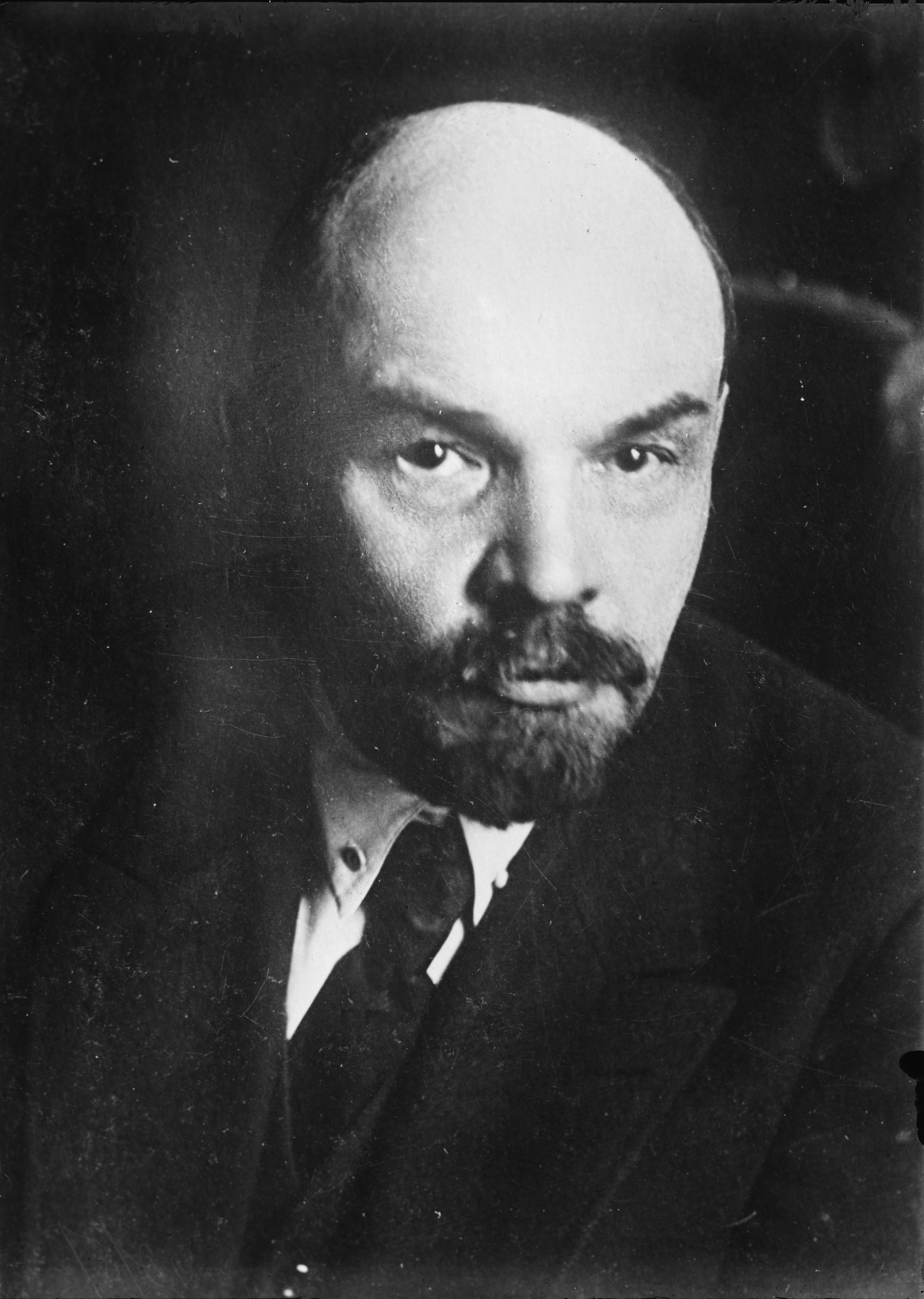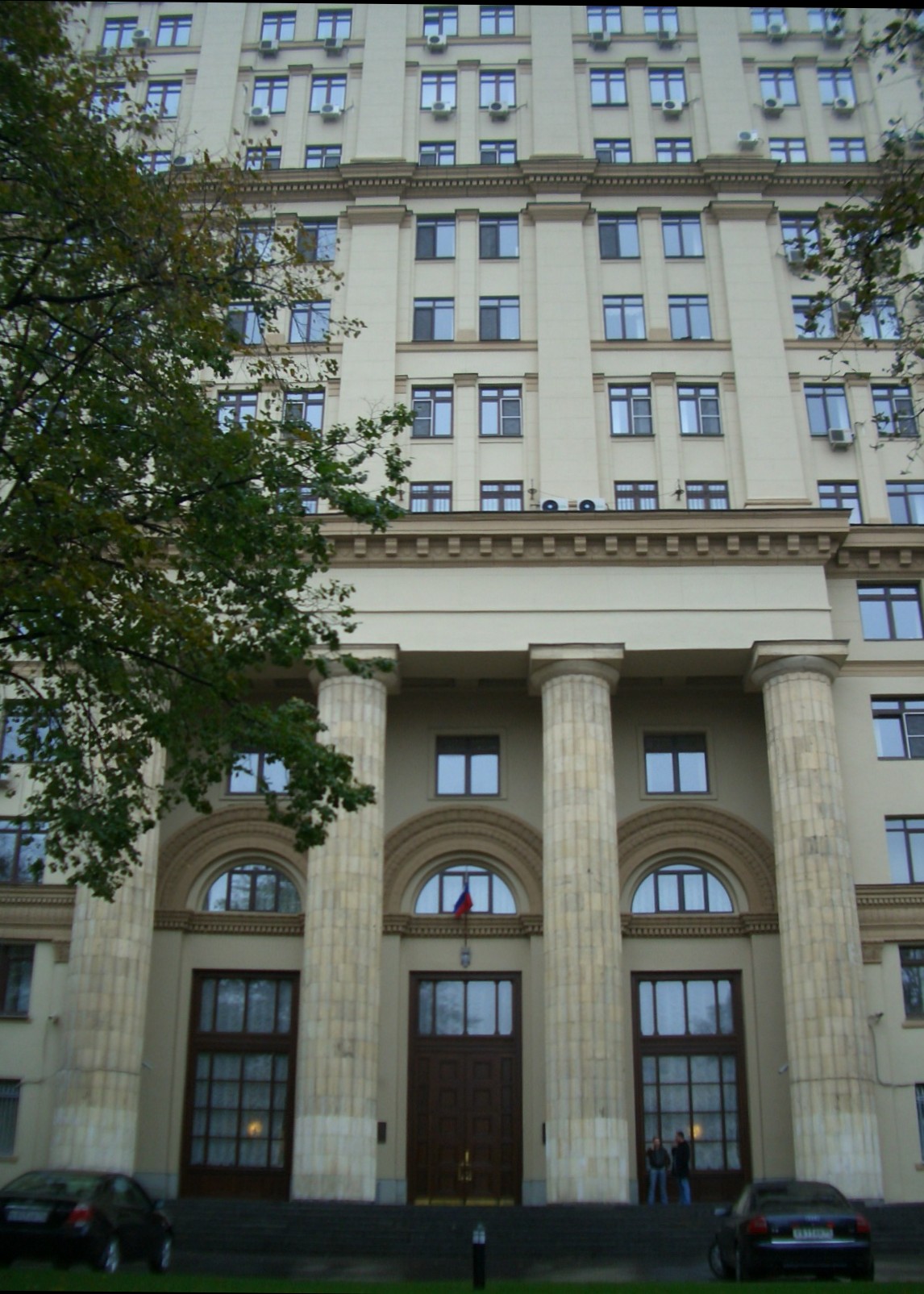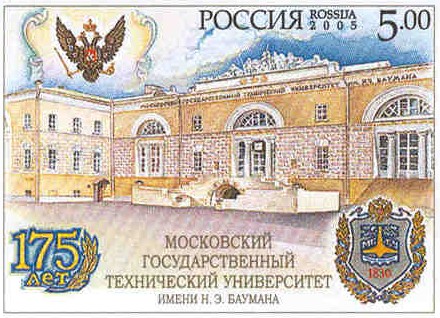|
Vyacheslav Malyshev
Viacheslav Aleksandrovich Malyshev (Russian: Вячеслав Александрович Малышев) (3 December 1902 — 20 February 1957) was a Soviet statesman who was one of the leading figures of Soviet industry during the 1940s and 1950s. He was a specialist in electrical engineering and shipbuilding and was instrumental in developing the Soviet's atomic bomb project and rocket and space technology. Early life Malyshev was born on 16 December 1902 in Ust’-Sysol’sk, Russian Empire, the son of teachers Alexander Nikolaevich Malyshev and Elena Konstantinovna Popova. He has one brother, A. Aleksandrovich Malyshev. The family moved to Velikiye Luki in 1904 after Malyshev's father accepted another teaching job. Between 1918—1920, he worked as a secretary for Velikiye Luki's People's Court. In 1920, he began attending the Railway Technology School in town and working as a locksmith at a railway depot in Podmoskovye. After graduating in 1924, he worked as a locksmi ... [...More Info...] [...Related Items...] OR: [Wikipedia] [Google] [Baidu] |
Ministry Of Heavy Machine Building
The Ministry of Heavy Machine Building (Mintyazhmash; russian: Министерство тяжёлого машиностроения СССР) was a government ministry in the Soviet Union. History The statute of the People's Commissariat of Heavy Machine Building was confirmed by a decree of the Council of People's Commissars on 23 April 1939. On 5 June 1941, when the Ministry of Machine Tool and Tool Building Industry was organized, it was given jurisdiction over a number of main administrations formerly belonging to the People's Commissariat of Heavy Machine Building. With the reorganization of the Council of People's Commissars into the Council of Ministers in 1946, the People's Commissariat of Heavy Machine Building became the Ministry of Heavy Machine Building. List of ministers ''Source'': * Vyacheslav Malyshev (19.6.1939 - 17.4.1940) * Aleksandr Yefremov (17.4.1940 - 6.6.1941) * Nikolai Kazakov (6.6.1941 - 6.3.1953; 19.4.1954 - 18.7.1955) * Konstantin Petukhov (18.7.1955 ... [...More Info...] [...Related Items...] OR: [Wikipedia] [Google] [Baidu] |
Velikiye Luki
Velikiye Luki ( rus, Вели́кие Лу́ки, p=vʲɪˈlʲikʲɪjə ˈlukʲɪ; lit. ''great meanders''. Г. П. Смолицкая. "Топонимический словарь Центральной России". "Армада-Пресс", 2002 (G. P. Smolitskaya. ''Toponymic Dictionary of Central Russia''. Armada-Press, 2002) or ''longbows'') is a town in Pskov Oblast, Russia, located on the meandering Lovat River. It is the second largest town in Pskov Oblast; population: Velikiye Luki is a City of Military Glory, an honor bestowed on it because of the courage and heroism its citizens displayed during World War II. History Velikiye Luki is first mentioned in a chronicle under the year of 1166 as Luki. From the 12th century, Luki was a part of the Novgorod Republic. After the construction of a fortress in 1211, Luki gained strategic importance, defending the approaches to Pskov and Novgorod. It was located near the border with Lithuania. The adjectiv ... [...More Info...] [...Related Items...] OR: [Wikipedia] [Google] [Baidu] |
Central Committee Of The Communist Party Of The Soviet Union
The Central Committee of the Communist Party of the Soviet Union, – TsK KPSS was the executive leadership of the Communist Party of the Soviet Union, acting between sessions of Congress. According to party statutes, the committee directed all party and governmental activities. Its members were elected by the Party Congress. During Vladimir Lenin's leadership of the Communist Party, the Central Committee functioned as the highest party authority between Congresses. However, in the following decades the ''de facto'' most powerful decision-making body would oscillate back and forth between the Central Committee and the Political Bureau or Politburo (and during Joseph Stalin, the Secretariat). Some committee delegates objected to the re-establishment of the Politburo in 1919, and in response, the Politburo became organizationally responsible to the Central Committee. Subsequently, the Central Committee members could participate in Politburo sessions with a consultative voic ... [...More Info...] [...Related Items...] OR: [Wikipedia] [Google] [Baidu] |
Ministry Of The Shipbuilding Industry (Soviet Union)
The People's Commissariat of the Shipbuilding Industry of the USSR (''Народный комиссариат судостроительной промышленности CCCP'') was one of the central offices in the Soviet Union, the equivalent of a ministry, which oversaw the production of shipbuilding. On January 11, 1939 the current People's Commissariat of Defence Industry of the USSR (''Народный комиссариат оборонной промышленности'') was divided into several departments, including II Main Board responsibility for shipbuilding, transformed into the People's Commissariat of the Shipbuilding Industry. Resort oversaw the work of 41 shipyards and manufacturing plants, also 10 design offices. In 1939 it employed 173,284 workers. March 15, 1946 the office was renamed the Ministry of Shipbuilding Industry of the USSR (''Министерство судостроительной промышленности CCCP''; Minsudprom). Headquarters ... [...More Info...] [...Related Items...] OR: [Wikipedia] [Google] [Baidu] |
NKVD
The People's Commissariat for Internal Affairs (russian: Наро́дный комиссариа́т вну́тренних дел, Naródnyy komissariát vnútrennikh del, ), abbreviated NKVD ( ), was the interior ministry of the Soviet Union. Established in 1917 as NKVD of the Russian Soviet Federative Socialist Republic, the agency was originally tasked with conducting regular police work and overseeing the country's prisons and labor camps. It was disbanded in 1930, with its functions being dispersed among other agencies, only to be reinstated as an all-union commissariat in 1934. The functions of the OGPU (the secret police organization) were transferred to the NKVD around the year 1930, giving it a monopoly over law enforcement activities that lasted until the end of World War II. During this period, the NKVD included both ordinary public order activities, and secret police activities. The NKVD is known for its role in political repression and for carrying out the Great ... [...More Info...] [...Related Items...] OR: [Wikipedia] [Google] [Baidu] |
Nuclear Submarine
A nuclear submarine is a submarine powered by a nuclear reactor, but not necessarily nuclear-armed. Nuclear submarines have considerable performance advantages over "conventional" (typically diesel-electric) submarines. Nuclear propulsion, being completely independent of air, frees the submarine from the need to surface frequently, as is necessary for conventional submarines. The large amount of power generated by a nuclear reactor allows nuclear submarines to operate at high speed for long periods, and the long interval between refuelings grants a range virtually unlimited, making the only limits on voyage times being imposed by such factors as the need to restock food or other consumables. The limited energy stored in electric batteries means that even the most advanced conventional submarine can only remain submerged for a few days at slow speed, and only a few hours at top speed, though recent advances in air-independent propulsion have somewhat ameliorated this disadv ... [...More Info...] [...Related Items...] OR: [Wikipedia] [Google] [Baidu] |
Ministry Of Transport Machine-Building Industry
The Ministry of Transport Machine-Building Industry (russian: Министерство транспортного машиностроения СССР) was one of the government ministries of the Soviet Union. Before 1946 it was known as the People's Commissariat of the Tank Industry of the USSR (''Народный комиссариат танковой промышленности СССР''). The seat was located in Moscow at Ryazanskaya St. (''Рязанская ул.'') 8а, then evacuated to Chelyabinsk. History The People's Commissariat of the Tank Industry was created 11 September 1941 on the basis of People's Commissariat of Middle Engineering Industry in conjunction with those of large losses of tanks in World War II. Similar commissariats existed at that time in other areas of the defense industry, such as aviation and NKTP was organized similarly. NKTP became one of the largest industrial ministries of the USSR. It consisted of a series of industrial giants, employing ... [...More Info...] [...Related Items...] OR: [Wikipedia] [Google] [Baidu] |
Council Of People's Commissars Of The Soviet Union
The Council of People's Commissars of the Soviet Union was the highest collegial body of executive and administrative authority of the Soviet Union from 1923 to 1946. As the government of the Soviet Union, the Council of People's Commissars of the Soviet Union and the People's Commissariats led by it played a key role in such significant events for the country and society as the economic recovery after the Civil War, the New Economic Policy, agricultural collectivization, electrification, industrialization, five-year plans for the development of national economy, censorship, the fight against religion, repression and political persecution, the Gulag, the deportation of peoples, the annexation of the Baltic States and other territories by the Soviet Union, the organization of the partisan movement, the organization of industrial production in the rear during the Great Patriotic War. In 1946, it was transformed into the Council of Ministers of the Soviet Union. History The ... [...More Info...] [...Related Items...] OR: [Wikipedia] [Google] [Baidu] |
Ministry Of Medium Machine Building
The Ministry of Medium Machine-Building Industry of the USSR (russian: Министерство среднего машиностроения СССР - Минсредмаш СССР, МСМ СССР) was the government ministry of the Soviet Union that supervised the Soviet nuclear industry, including production of nuclear warheads. The headquarters was located in Moscow in the building at Bolshaya Ordynka St. (''Большая Ордынка'') 24-26, currently occupied by the corporation Rosatom. History The basis of the ministry was established since September 1942 the First Chief Directorate (nuclear industry), the Third Chief Directorate (development in the area controlled missiles, aircraft, rockets and long range missiles) of the Council of Ministers of the USSR and the Central Board of Industrial Building of the Ministry of Internal Affairs of the USSR (''Главпромстрой МВД'') charged with construction of nuclear installations. The Ministry of Medium Mach ... [...More Info...] [...Related Items...] OR: [Wikipedia] [Google] [Baidu] |
Ministry Of Heavy Machine Building (Soviet Union)
The Ministry of Heavy Machine Building (Mintyazhmash; russian: Министерство тяжёлого машиностроения СССР) was a government ministry in the Soviet Union. History The statute of the People's Commissariat of Heavy Machine Building was confirmed by a decree of the Council of People's Commissars on 23 April 1939. On 5 June 1941, when the Ministry of Machine Tool and Tool Building Industry was organized, it was given jurisdiction over a number of main administrations formerly belonging to the People's Commissariat of Heavy Machine Building. With the reorganization of the Council of People's Commissars into the Council of Ministers in 1946, the People's Commissariat of Heavy Machine Building became the Ministry of Heavy Machine Building. List of ministers ''Source'': * Vyacheslav Malyshev (19.6.1939 - 17.4.1940) * Aleksandr Yefremov (17.4.1940 - 6.6.1941) * Nikolai Kazakov (6.6.1941 - 6.3.1953; 19.4.1954 - 18.7.1955) * Konstantin Petukhov (18.7.1955 ... [...More Info...] [...Related Items...] OR: [Wikipedia] [Google] [Baidu] |
Kolomna Locomotive Works
The Kolomna Locomotive Works (Kolomensky Zavod) is a major producer of railroad locomotives as well as locomotive and marine diesel engines in Russia. The plant started production in 1869 with a freight steam locomotive, one of the first in Russia. In the Czarist period before the Russian Revolution, Kolomna was one of a very few producers in Russia. During this period 139 types of steam locomotives were designed. The company is now (2015) a part of Transmashholding. Overview The main activities of the company are: design, manufacturing and service of diesel engines (medium-speed diesel engines and diesel generators for diesel locomotives, power plants, heavy trucks, ships), mainline locomotives (passenger and freight), DC passenger electric locomotives. The Kolomna plant is the only Russian producer of passenger locomotives, the creator of the first domestic examples of the main high-speed passenger EP200 AC locomotives, passenger DC electric EP2K, freight locomotives ... [...More Info...] [...Related Items...] OR: [Wikipedia] [Google] [Baidu] |
Bauman Moscow State Technical University
The Bauman Moscow State Technical University, BMSTU (russian: link=no, Московский государственный технический университет им. Н. Э. Баумана (МГТУ им. Н. Э. Баумана)), sometimes colloquially referred to as the Bauman School or Baumanka (russian: link=no, Ба́уманка) is a public technical university (Polytechnic) located in Moscow, Russia. Bauman University a Russian technical university offering B.S., M.S. and PhD degrees in various engineering fields and applied sciences. History Bauman University is the second oldest educational institution in Russia after Lomonosov Moscow State University (1755). In 1763, the Russian empress Catherine II founded the Educational Imperial House. On October 5 1826 the Dowager Empress Maria Feodorovna issued a decree to establish "great workshops for different crafts with bedrooms, a dining room, etc." as a part of the Moscow Foundling Home in the German Quarte ... [...More Info...] [...Related Items...] OR: [Wikipedia] [Google] [Baidu] |






